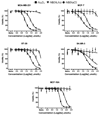A novel nanoparticulate formulation of arsenic trioxide with enhanced therapeutic efficacy in a murine model of breast cancer
- PMID: 20519360
- PMCID: PMC2943376
- DOI: 10.1158/1078-0432.CCR-10-0068
A novel nanoparticulate formulation of arsenic trioxide with enhanced therapeutic efficacy in a murine model of breast cancer
Abstract
Purpose: The clinical success of arsenic trioxide (As(2)O(3)) in hematologic malignancies has not been replicated in solid tumors due to poor pharmacokinetics and dose-limiting toxicity. We have developed a novel nanoparticulate formulation of As(2)O(3) encapsulated in liposomal vesicles or "nanobins" [(NB(Ni,As)] to overcome these hurdles. We postulated that nanobin encapsulation of As(2)O(3) would improve its therapeutic index against clinically aggressive solid tumors, such as triple-negative breast carcinomas.
Experimental design: The cytotoxicity of NB(Ni,As), the empty nanobin, and free As(2)O(3) was evaluated against a panel of human breast cancer cell lines. The plasma pharmacokinetics of NB(Ni,As) and free As(2)O(3) were compared in rats to measure drug exposure. In addition, the antitumor activity of these agents was evaluated in an orthotopic model of human triple-negative breast cancer.
Results: The NB(Ni,As) agent was much less cytotoxic in vitro than free As(2)O(3) against a panel of human breast cancer cell lines. In contrast, NB(Ni,As) dramatically potentiated the therapeutic efficacy of As(2)O(3) in vivo in an orthotopic model of triple-negative breast cancer. Reduced plasma clearance, enhanced tumor uptake, and induction of tumor cell apoptosis were observed for NB(Ni,As).
Conclusions: Nanobin encapsulation of As(2)O(3) improves the pharmacokinetics and antitumor efficacy of this cytotoxic agent in vivo. Our findings demonstrate the therapeutic potential of this nanoscale agent and provide a foundation for future clinical studies in breast cancer and other solid tumors.
Copyright 2010 AACR.
Figures





Similar articles
-
Folate-mediated intracellular drug delivery increases the anticancer efficacy of nanoparticulate formulation of arsenic trioxide.Mol Cancer Ther. 2009 Jul;8(7):1955-63. doi: 10.1158/1535-7163.MCT-09-0045. Epub 2009 Jun 30. Mol Cancer Ther. 2009. PMID: 19567824 Free PMC article.
-
pH-triggered sustained release of arsenic trioxide by polyacrylic acid capped mesoporous silica nanoparticles for solid tumor treatment in vitro and in vivo.J Biomater Appl. 2016 Jul;31(1):23-35. doi: 10.1177/0885328216637211. Epub 2016 Apr 7. J Biomater Appl. 2016. PMID: 27059495
-
Resveratrol and arsenic trioxide act synergistically to kill tumor cells in vitro and in vivo.PLoS One. 2014 Jun 5;9(6):e98925. doi: 10.1371/journal.pone.0098925. eCollection 2014. PLoS One. 2014. PMID: 24901647 Free PMC article.
-
Cell-penetrating properties of the transactivator of transcription and polyarginine (R9) peptides, their conjugative effect on nanoparticles and the prospect of conjugation with arsenic trioxide.Anticancer Drugs. 2012 Jun;23(5):471-82. doi: 10.1097/CAD.0b013e32835065ed. Anticancer Drugs. 2012. PMID: 22241171 Review.
-
Arsenic trioxide - An old drug rediscovered.Blood Rev. 2010 Jul-Sep;24(4-5):191-9. doi: 10.1016/j.blre.2010.04.001. Epub 2010 May 15. Blood Rev. 2010. PMID: 20471733 Free PMC article. Review.
Cited by
-
3D tumor tissue analogs and their orthotopic implants for understanding tumor-targeting of microenvironment-responsive nanosized chemotherapy and radiation.Nanomedicine. 2015 Nov;11(8):2013-23. doi: 10.1016/j.nano.2015.07.013. Epub 2015 Aug 15. Nanomedicine. 2015. PMID: 26282381 Free PMC article.
-
Metals and breast cancer: risk factors or healing agents?J Toxicol. 2011;2011:159619. doi: 10.1155/2011/159619. Epub 2011 Jul 24. J Toxicol. 2011. PMID: 21804822 Free PMC article.
-
PML promotes metastasis of triple-negative breast cancer through transcriptional regulation of HIF1A target genes.JCI Insight. 2017 Feb 23;2(4):e87380. doi: 10.1172/jci.insight.87380. JCI Insight. 2017. PMID: 28239645 Free PMC article.
-
Arsenic in medicine: past, present and future.Biometals. 2023 Apr;36(2):283-301. doi: 10.1007/s10534-022-00371-y. Epub 2022 Feb 21. Biometals. 2023. PMID: 35190937 Free PMC article. Review.
-
Polymer-caged nanobins for synergistic cisplatin-doxorubicin combination chemotherapy.J Am Chem Soc. 2010 Dec 8;132(48):17130-8. doi: 10.1021/ja107333g. Epub 2010 Nov 15. J Am Chem Soc. 2010. PMID: 21077673 Free PMC article.
References
-
- Jemal A, Siegel R, Ward E, et al. Cancer Statistics, 2006. CA Cancer J Clin. 2006;56:106–130. - PubMed
-
- Schneider BP, Winer EP, Foulkes WD, et al. Triple-negative breast cancer: risk factors to potential targets. Clin Cancer Res. 2008;14:8010–8018. - PubMed
-
- Dent R, Trudeau M, Pritchard KI, et al. Triple-Negative Breast Cancer: Clinical Features and Patterns of Recurrence. Clin Cancer Res. 2007;13:4429–4434. - PubMed
Publication types
MeSH terms
Substances
Grants and funding
LinkOut - more resources
Full Text Sources
Other Literature Sources
Medical
Research Materials

